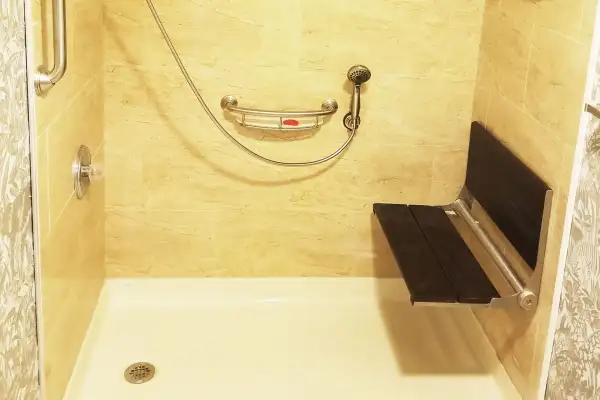3 Home Renovations That Will Help You Live Independently as You Get Older

Many Americans spend decades preparing for retirement financially, but overlook another key aspect of planning: housing.
Three quarters of Americans age 50 and over say they want to remain in their homes as they age, according to a survey by AARP, but few are making modifications to help them accomplish that goal.
Indeed, most people don't try to make their home more navigable until there's a crisis, says Ernie Mac Neill, a contractor based in Pine Brook, N.J. who is a Certified Aging-in-Place Specialist (CAPS), an expert who has training in modifying homes for people to age in place.
"One day everything is okay, they have their home, they can function okay, but then they fall,” he says of one of the most common reasons clients seek him out. “It changes the whole trajectory of their life.”
Sixty-five million households in the U.S. are now headed by someone over the age of 50, according to a report by the Joint Center for Housing Studies of Harvard University, but only 3.5% of the country's housing stock incorporates three vital features for aging in place: single-floor living, no-step entries, and extra-wide halls and doors, the report says.
Some older people relocate to assisted living for such age-friendly features. For those who would rather stay put, Mac Neill steers his clients towards single-floor living when he can. Rather than install a chairlift on a staircase to access the second floor, it often makes sense to convert a room like the dining room and move the master bedroom downstairs. Living on a single floor can also help cut down on renovation costs--for example, it may allow you to widen only a few doorways instead of many on both floors.
With the right documentation, certain aging-in-place modifications meet the criteria for a tax write-off. For example, in some cases a home adaption like a wheelchair ramp will qualify as a deductible medical expense. Veterans may also be eligible for financial assistance from the Department of Veterans Affairs.
Here are some of the most practical home modifications older adults can make to continue living independently for as long as possible, along with cost estimates for each (actual costs vary by contractor and location). If they seem expensive, consider that the cost of inaction could also be high, in the form of pricey medical bills following an accident, or even the expense of relocating to a care facility if you can no longer stay at home:
Bathroom Fixes
Grab bars: $50 each plus $100 for installation
Walk-in shower: $4,000 to $6,000
One in four Americans age 65-plus falls each year, making falls the biggest cause of fatal and non-fatal injuries in older Americans. And the place where people fall the most? The bathroom, says Mac Neill. You can make inexpensive changes like installing grab bars by the shower and toilet, or more costly, extensive changes like removing your bathtub and installing a walk-in shower. Hand-held shower heads that you can move toward you, rather than having to move yourself, help as well. Bonus: your bathroom doesn’t have to look like a hospital facility with age-appropriate adaptions. There are plenty of ADA compliant products that are attractive and blend in nicely to existing homes, Mac Neill says.
Flooring and Lighting
Flooring replacement: Around $12.50 per square foot to rip up carpet and install new laminate flooring
Non-glare LED lightbulbs: starting at $6
Consistency is key when it comes to both flooring and lighting. Muscle weakness, joint pain and other issues can make it harder for older adults to navigate different surfaces, moving from hardwood hallways to a carpeted living room to tile in the kitchen. So Mac Neill strives to keep the flooring as similar as possible throughout a house, sometimes ripping up wall-to-wall carpeting in the process. If there is nice hardwood underneath the carpet he will often leave it; otherwise, he replaces it with a variety of laminate flooring. Also, he removes area rugs, which are a fall hazard.
Keeping your lighting levels the same throughout the house is also important, as vision sometimes declines with age. Uniform lighting means your eyes don't have to adjust every time you leave a room, helping you keep your balance. You should situate your lighting to make every room as bright as possible: use higher wattage bulbs that help prevent glare (for as little as $6) or have motion sensor lights installed that turn on automatically when you enter a room. Consider remote-control lighting for those with serious mobility issues.
Entryways and Wheelchair Ramps
Doorway widening: $400-$800 per door
Wheelchair ramps: $5,000-$6,000 for a temporary ramp; $12,000-14,000 for a permanent ramp
Doorways in older homes tend to be narrower than the currently recommended 32 inches wide, and as such can't comfortably accommodate wheelchairs and walkers. While many newer homes have wider doorways (the International Residential Code requires that doors be at least 32 inches wide), CAPS recommends going even wider, to 36 inches, to provide clear access for most wheelchairs and walkers. Mac Neill says he charges anywhere from $400-$800 per door, depending on whether other elements like light switches also have to be moved, although other contractors may charge more. Wheelchair ramps can cost anywhere from $5,000-$6,000 for a temporary aluminum ramp to $12,000-14,000 for a permanent structure attached to a house with around eight steps.